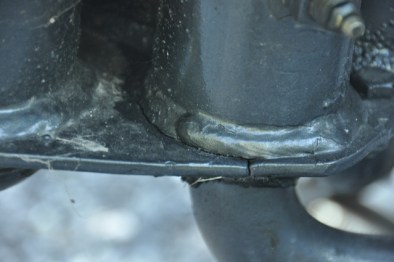As I mentioned in the last post, we are anticipating leaving Vermont soon. A cold front swept through on Wednesday and with that swift stroke, summer has ended. We are now wearing sweatshirts and long pants, and running the furnace in the Airstream at night when the temperature drops into the 40s. A few early red leaves have dropped into the gravel driveway around us, and the Champlain Valley Fair starts this weekend. All the signs are there for the coming of Fall.
With the various problems we’ve encountered over the years while traveling, I’ve learned to do a pre-trip equipment inspection well in advance of departure. Checking the gear the day you plan to leave just means that any problems you find will automatically delay your trip. So last night I did a sweep of the Airstream exterior, and sure enough, I found this on the Hensley hitch.
That’s a crack in the lower part of the main hitch assembly, where the weight transfer bar (“spring bar”) enters the hitch head. There’s a crack clean through the base plate and then extending about 1/4 around the weld. The crack goes all the way through to the bottom.
 This is a high-stress area of the hitch. The load imposed by the weight transfer bar puts a lot of stress at this point. The Hensley is extremely sturdy, but nothing made of metal is unbreakable. This hitch has about 70,000 miles on it, and I haven’t babied it.
This is a high-stress area of the hitch. The load imposed by the weight transfer bar puts a lot of stress at this point. The Hensley is extremely sturdy, but nothing made of metal is unbreakable. This hitch has about 70,000 miles on it, and I haven’t babied it.
The good news is that I spotted it several days before we had planned to leave. The other good news is that it can be repaired locally by a welder, or through a free exchange under Hensley’s lifetime original owner warranty. I called Hensley today and we agreed that even though a local repair would be quicker, I might as well get a refurbished hitch head under the warranty. I will pay the shipping costs both ways, which will cost about $165.
The replacement hitch will arrive on Wednesday. This will delay our departure by a couple of days, but not seriously impact our plans. The lesson here is that it pays to inspect everything a week or so before you plan to take off. It could have been anything on the Airstream or the tow vehicle. When I think of all the things that have gone wrong on us in the past (tires, wheel studs, hitch, brakes, electrical ground, receiver, battery, etc.) I can see how a good safety inspection is required before each and every trip.
You’ll see a bit of emphasis on safety issues in upcoming issues of Airstream Life magazine. I am working with three different authors at present, to develop well-researched articles on towing issues, hitch inspection, and checklists. Airstream reports that nearly 1/3 of new Airstream trailers are being bought by people who have never owned any type of RV before. That means there a lot of people out there thirsting for reliable information on what they should do. A tremendous amount of misinformation is floating around on the Internet, so I feel it’s an obligation of publications in the industry to do some “myth-busting” and help prepare newbie owners to travel safely. As this episode demonstrates, one of the most effective tools that anyone can use is a pair of open eyes.







